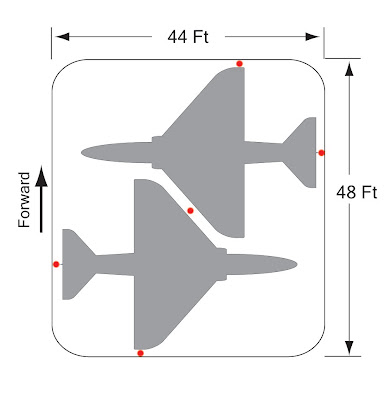In my 28 June 2009 post, I speculated that the A4D's span was set by the 58-ft length of the Essex-class forward elevator after the angled-deck conversion. Too conveniently, 27.5 feet times two plus one-foot clearance between the aircraft and the edge of the elevator equaled 58 feet. What I didn't realize was that the forward elevator was only open to the hangar deck on its aft side, the narrower one, so the Skyhawks loaded athwartships couldn't be moved unless the wheels were on dollies.
The correct loading is shown here and I've also revised the June post.
However, even before I realized my blunder with respect to access to the hangar, I had been bothered as to why the 58-foot long elevator was used as the criteria, since it was the biggest centerline elevator, introduced with the SCB 27A change. Most were smaller. The centerline elevators on the Essex before conversion were 48 feet by 44 feet; those on the Midway class before conversion had a maximum dimension of 54 feet. It turned out that the 27 feet 6 inches was consistent with the original Essex elevators when the aircraft were positioned athwartships and headed at each other. (This was probably established before the slats were reintroduced in the configuration, but since they were easily stowed, the lack of one-foot clearance with the slats extended was not a problem.)
Of course, the Skyhawks still had to be positioned fore and aft on the forward elevator and angled for loading and unloading, but they fit. Note that angling was undesirable because of the extra time it took for positioning and the added risk of a crunch...






4 comments:
I have to be at least slightly skeptical of any placement that constrains the design by multiple degrees of freedom (eg the two LE's being collinear and adjacent as drawn, and tightly controlled in terms of axial location). I can certainly imagine such a spotting configuration being used in service, or drawn up as a pleasing coincidence of the design before presenting the design to BuAir, but it seems implausibly limiting in the preliminary design of the aircraft.
See the 28 June 2009 post for an example of a similar layout scanned from a Vought proposal in the early 1950s. Another notorious example of spotting constraining the design is the SB2C Helldiver.
I certainly have followed your discussions of spotting being a serious constraint on configuration, but if you've limited span, sweep, aircraft length and wing position, and you've got severe (ie Navy) low-speed requirements, then you've in every way sized the aircraft.
From where I sit, there's a substantial difference between limiting length and dictating wing size, shape and placement. It does not entirely mesh with what (comparatively little) I understand of the development history of the A-4.
My history of the development of the Skyhawk will be available from Specialty Press in early 2011.
Post a Comment